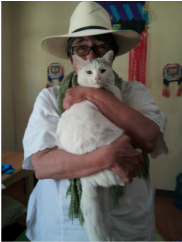than the fish. An adult sea turtle was making her way to the surface. She seemed to fly like a giant bird, each stroke of her flippers taking her much farther than the constant flutter of the small fins of the fish below me. When she reached the surface
she tipped her head to take a few breaths of air. Then she parted the water with her
fins and moved into the deeper ocean, fortified with oxygen that could last her for another hour. Sea turtles can
live to be 100 years old. Their lineage dates to the time of the dinosaurs when it was believed they were land
creatures who took to the sea at around the time dinosaurs became extinct, trading their capacity to hide for the ability to swim great distances. The Mayans believe that the creator god was birthed from a sea turtle carapice. When I snorkeled, I I found that the turtles would look right at me. I moved to Hawaii because I fell in love with them.
It was not possible to see a baby turtle in Hawaii as the mother turtles do not nest on the major islands.
And so I was very excited when I learned that Guatemala’s Pacific Coast iss a major nesting area for Olive Ridley and Loggerhead sea turtles. Sea turtle reserves, tortugarias, dot the coast, but the reserve at Monterrico, which also rescues endangered iguanas and alligators, was the most accessible for me.
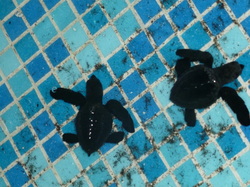
I heard there was to be a release of baby sea turtles at 5:30 that
afternoon at the Monterrico reserve.
When I arrived at the reserve, which is only a short walk down the beach,
I was led to a pool where 25 baby turtles were swimming, some of them very
rapidly. Unlike other animals which assume an adult shape only with maturity, baby sea turtles are perfect miniatures of the adult .sea turtles. As they scampered in the still water of the pool, waving their tiny flippers energetically, they resembled migrating butterflies. I felt a great fondness watching them and imagined sending them love and protection for their perilous journeys to adulthood.
The tortugaria staff told us to head for the beach in front of the hatchery. We peered in through the mesh surrounding the hatchery, where rows of marked PCP pipes indicated the reburied nests. Then baby sea turtles from the pool
were carried in a dry bucket to within 6 feet of the ocean wash. The turtles need to be released on the sand and to enter the sea by land.
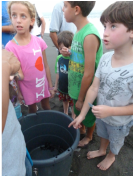
dip into the bucket with my hands and bring out a baby turtle.
Unfortunately, there was little in the way of education about the baby
turtles and no guidelines for the release, so the turtles were taken from the
bucket with varying degrees of consideration. Later, I talked with a woman who
works at another reserve and I heard there was criticsm of this reserve because
they sometimes held the turtles for a day or even two days after hatching, so as
to have a sufficient number of turtles for tourists at the late afternoon
release. She said that research done at her reserve suggests that the baby turtles have only two days of enormous energy before they become lethargic and so it is important that they are released within an hour of being
hatched. She proposes that people sign up to participate in the release so that people could be notified of the
release shortly after the turtles hatch.
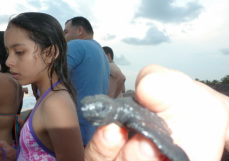
I was immediately aware of how mighty the little turtle in my
hand was, so much stronger than a baby bird or a kitten, repeatedly flexing her
fins as if she was already making her way through the waves.
I quickly said a prayer to Gaia on her behalf and gave her a little reiki
before setting her on the sand.
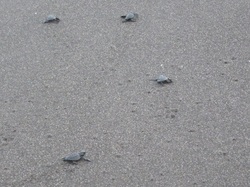
On the vast beach she looked small, only slightly larger than a
pebble. But she moved determinedly
towards the water, hoisting herself forward with her flippers until she caught
the wash of an incoming wave.
I have thought of “my” turtle many times since that day.
After the release I checked my email at the hotel and found that my
dearly beloved cat, Frankie Topaz, had died that afternoon at nearly the same
hour that I released my turtle into the sand. I called in my mind to my baby
turtle. I said I would name her Topaz in honor of another fine animal.
Perhaps like my beloved cat and like the sea turtles I swam with in Hawaii, Topaz the Turtle will also
survive into maturity and one day open the heart of a human who chances to travel beside her.

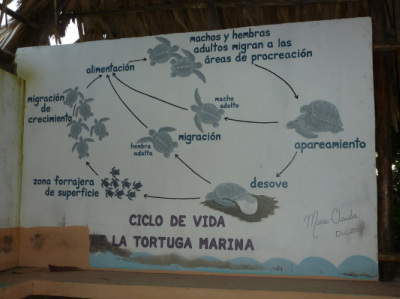
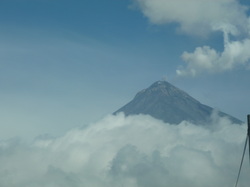
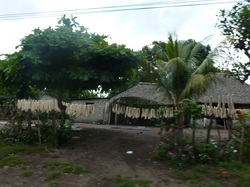
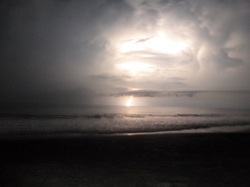
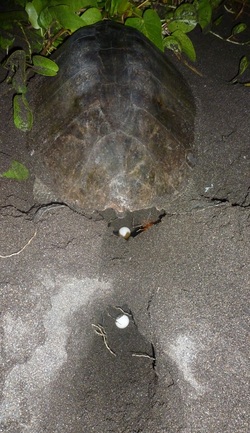
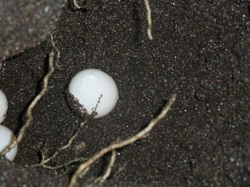
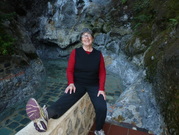
 RSS Feed
RSS Feed
